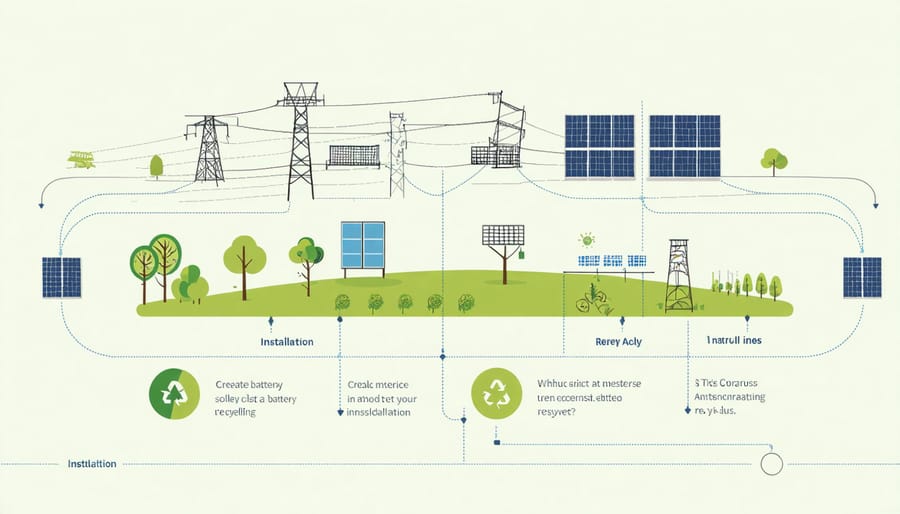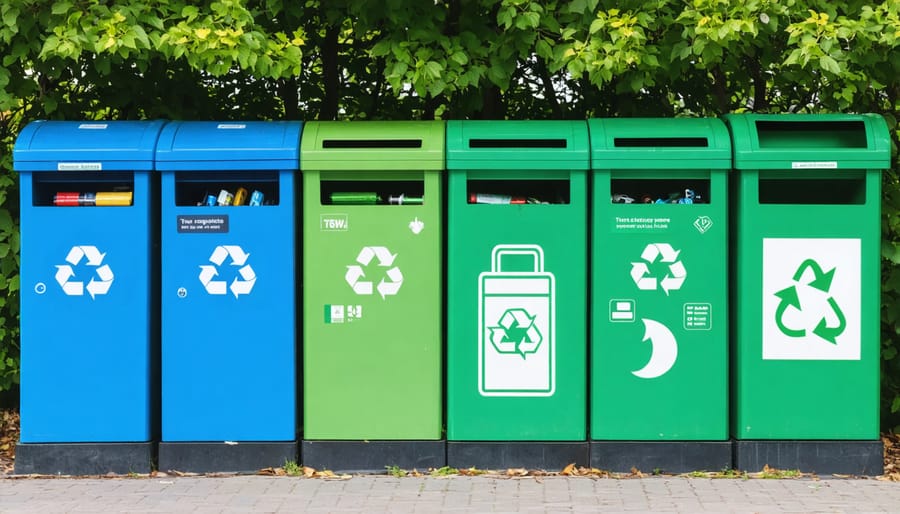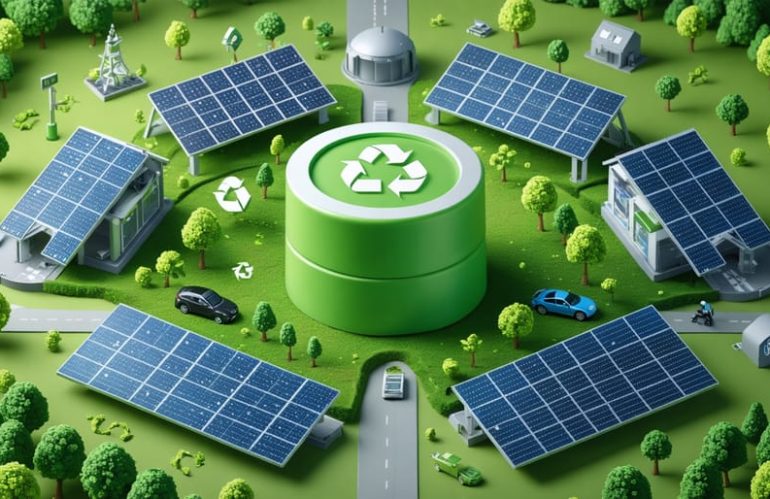Battery recycling facilities represent a crucial link in our sustainable energy future, transforming end-of-life battery energy storage systems into valuable resources while protecting our environment. As solar installations and electric vehicles become increasingly common in American homes, these specialized facilities recover up to 95% of battery materials for reuse, significantly reducing landfill waste and raw material demand. Modern recycling centers employ advanced chemical and mechanical processes to safely extract valuable metals like lithium, cobalt, and nickel, creating a circular economy that benefits both homeowners and the planet. Understanding how these facilities operate not only helps responsible battery disposal but also supports the growing renewable energy ecosystem that powers our sustainable future.
Why Battery Recycling Matters for Solar Homeowners
The Environmental Impact of Battery Waste
Improper battery disposal poses significant environmental risks that affect both our ecosystems and human health. When batteries end up in landfills, their toxic components, including lead, mercury, and cadmium, can leach into soil and groundwater. This contamination threatens local wildlife, plant life, and drinking water supplies. A single lithium-ion battery can contaminate up to 167,000 liters of water, making proper disposal crucial for environmental protection.
Beyond water contamination, improperly disposed batteries can release harmful greenhouse gases and potentially cause fires in waste management facilities. These fires not only endanger workers but also release toxic fumes into the atmosphere. The good news is that up to 95% of battery components can be recovered through proper recycling, creating a sustainable cycle that reduces the need for new raw materials while protecting our environment. By choosing responsible disposal methods, we can significantly reduce these environmental impacts while supporting a more sustainable future.
Your Solar Battery’s Lifecycle
Modern solar batteries are built to last, with a typical solar battery lifespan ranging from 10 to 15 years. During this time, your battery will complete thousands of charge and discharge cycles while maintaining reliable performance. However, like all technology, batteries gradually lose capacity over time. You’ll know it’s time to consider recycling when your battery holds less than 70% of its original capacity or shows significant performance decline.
Most homeowners find their batteries need replacement after about 10 years of regular use. This timeline can vary depending on usage patterns, maintenance, and environmental conditions. The good news is that by the time your battery needs recycling, newer, more efficient models will be available, offering improved storage capacity and enhanced features.
Don’t wait until your battery completely fails to plan for recycling. Start researching recycling options when your battery reaches the 8-year mark to ensure a smooth transition.

Modern Battery Recycling Technology
Safe Collection and Transportation
Safe battery collection begins with proper packaging in sturdy, non-conductive containers. Used batteries should be individually wrapped or have their terminals taped to prevent short circuits. Many retailers and hardware stores offer designated collection points where you can drop off your used batteries free of charge.
Licensed transportation companies use specialized vehicles equipped with fire suppression systems and spill containment measures. These vehicles follow strict Department of Transportation (DOT) guidelines for hazardous material handling. Drivers undergo extensive training in emergency response procedures and proper documentation.
To ensure safe transport, batteries are sorted by chemistry type and packaged in DOT-approved containers with appropriate labeling. Each shipment includes detailed manifests tracking the batteries from collection point to recycling facility. GPS tracking systems monitor the location of battery shipments in real-time, providing additional security.
For larger battery systems, such as those from solar installations, recycling facilities often provide on-site pickup services with their own trained technicians who properly disconnect and package the batteries for transport. This service ensures safe handling from start to finish.

The Recycling Process
When batteries arrive at recycling facilities, they undergo a carefully managed process to recover valuable materials. First, batteries are sorted by type and chemistry to ensure proper handling. They’re then discharged completely to prevent any safety hazards during processing.
The batteries enter a mechanical shredder that breaks them down into small pieces. These pieces pass through a hammermill, which further crushes the materials into a fine powder. This powder mixture contains valuable metals like lithium, cobalt, and nickel.
Next, the materials go through separation processes. A screening system removes plastic and paper components, while magnetic separation pulls out steel casings. The remaining mixture undergoes hydrometallurgical treatment, where specific chemicals help extract and purify the valuable metals.
These recovered materials don’t go to waste – they become raw materials for new batteries and other products. For example, recovered lithium can be used in new batteries, while extracted steel and copper find homes in various manufacturing applications. This closed-loop system helps reduce the need for new mining while keeping harmful materials out of landfills.
Finding Responsible Recycling Solutions
Local Recycling Programs
Many communities offer convenient battery recycling options through local programs and designated drop-off locations. Most hardware stores, including Home Depot and Lowe’s, maintain collection bins for household batteries and often accept larger batteries from solar systems. These retailers partner with certified recycling facilities to ensure proper battery disposal methods are followed.
Check with your local waste management authority, as many operate specialized collection events throughout the year. These events typically accept all types of batteries, from small alkaline units to larger solar storage batteries. Some municipalities also provide curbside pickup services for batteries when scheduled in advance.
Many auto parts stores accept lead-acid batteries free of charge and may even offer a small credit toward your next purchase. Additionally, some solar installation companies provide take-back programs for their customers, making it easier to responsibly dispose of end-of-life solar batteries.
To find the nearest recycling location, visit Earth911.com or call2recycle.org and enter your zip code. These websites maintain comprehensive databases of recycling facilities and drop-off points across the country. Remember to store batteries in a cool, dry place and tape the terminals before transport to prevent any safety hazards during handling.

Working with Solar Providers
Solar providers are increasingly taking an active role in battery recycling, making it easier for homeowners to dispose of their old solar batteries responsibly. Many solar companies now offer comprehensive end-of-life services as part of their installation packages, handling the entire recycling process on behalf of their customers.
When you work with a solar provider for battery recycling, they typically handle all the logistics, from safe removal and transportation to ensuring proper recycling at certified facilities. Most reputable companies include this service in their maintenance agreements or offer it as an add-on service, saving you the hassle of finding a recycling solution on your own.
These companies often partner with specialized recycling facilities that can process various types of solar batteries, including lithium-ion, lead-acid, and newer battery technologies. They ensure that valuable materials are recovered and harmful components are disposed of properly, following all environmental regulations.
To make the most of these services, it’s recommended to:
– Ask about recycling programs when purchasing your solar system
– Keep documentation of your battery warranty and installation date
– Contact your provider several months before your battery’s expected end-of-life
– Request information about their recycling partners and processes
Many solar providers also offer incentives or credit towards new battery purchases when you recycle your old units through their programs, making it both environmentally and financially beneficial to work with them for battery disposal.
The Future of Battery Recycling
The future of battery recycling looks increasingly bright, with innovative technologies and methods emerging to make the process more efficient and environmentally friendly. One of the most promising developments is the introduction of automated sorting systems that use artificial intelligence to identify and separate different types of batteries with unprecedented accuracy.
Several companies are developing chemical processes that can recover up to 98% of battery materials, a significant improvement over current methods. These new techniques not only reduce waste but also make battery recycling more economically viable for both facilities and consumers.
Researchers are also working on designing batteries with recycling in mind, known as “circular batteries.” These new batteries are built to be easily disassembled, making the recycling process simpler and more cost-effective. This approach could revolutionize how we think about battery lifecycle management.
Mobile recycling units are another exciting innovation on the horizon. These portable facilities can process batteries on-site at large solar installations or commercial properties, reducing transportation costs and environmental impact. Some companies are even developing small-scale recycling solutions for community centers and local waste management facilities.
The integration of renewable energy in recycling facilities is becoming more common, with many new facilities powered by solar and wind energy. This development further reduces the environmental impact of the recycling process while lowering operational costs.
As battery technology continues to evolve, recycling methods are adapting to handle new chemical compositions and designs. Industry experts predict that by 2030, automated recycling facilities will be able to process virtually any type of battery with minimal human intervention, making battery recycling more accessible and efficient than ever before.
As we’ve explored, battery recycling facilities play a crucial role in creating a sustainable future for our energy storage systems. By properly recycling batteries, we not only protect our environment from harmful materials but also conserve valuable resources that can be used to manufacture new batteries. The recycling process has become increasingly efficient, with modern facilities capable of recovering up to 95% of battery materials for reuse.
Taking responsibility for proper battery disposal is easier than ever, with numerous convenient drop-off locations and collection programs available in most communities. Remember to always separate different types of batteries, store them safely, and never dispose of them in regular household trash. Many retailers and hardware stores offer free battery collection services, making it simple to do your part.
By choosing to recycle your batteries, you’re contributing to a circular economy and helping reduce the environmental impact of energy storage solutions. Let’s all commit to responsible battery disposal practices and encourage others in our community to do the same. Together, we can ensure a cleaner, more sustainable future for generations to come.









